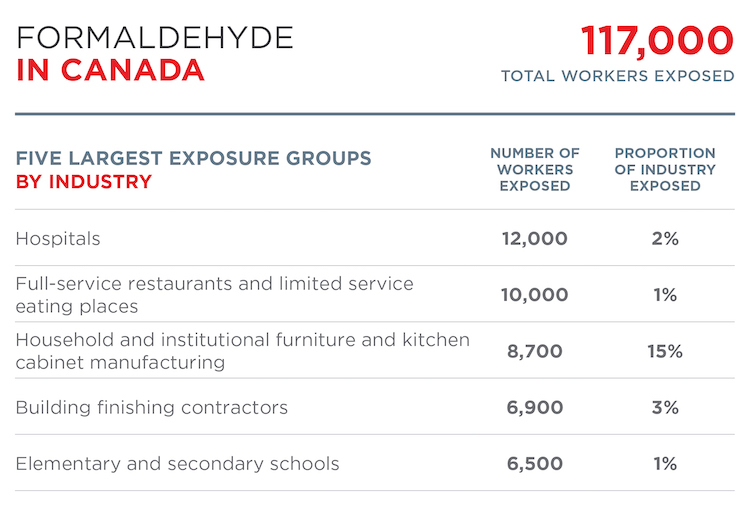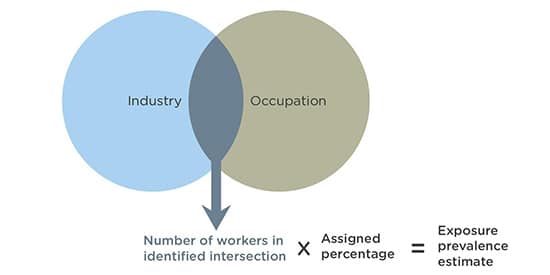Formaldehyde Occupational Exposures
Formaldehyde Occupational Exposures
Overview
Inhalation is the main route of exposure for formaldehyde. However, lower levels of exposure may occur via dermal absorption or ingestion.[1] CAREX Canada estimates that approximately 117,000 Canadians are exposed to formaldehyde in their workplaces. Currently, the three most important sources of formaldehyde exposure include decomposition of formaldehyde-containing resins, emissions from solutions (e.g. embalming fluid), and combustion sources (e.g. vehicle exhaust).[2]
READ MORE...
Although exposure to formaldehyde has decreased over time, exposure still occurs in a wide variety of occupations and industries. Hospitals and full-service restaurants and limited service eating places are among the largest exposed industrial groups in Canada. In terms of occupations, the largest groups of workers exposed to formaldehyde are cooks, motor vehicle assemblers, inspectors and testers, registered nurses and registered psychiatric nurses, and furniture and fixture assemblers and inspectors.
In wood panel manufacturing, formaldehyde is released when heating adhesives, which can expose press operating and maintenance workers.[3] In furniture manufacturing, formaldehyde is released when preparing and applying varnishes or paints (especially when applied with a spray gun), and drying. Therefore, painters, manual labourers working at dryers, and maintenance workers can also be exposed.[3]
Other occupations with acute exposure to formaldehyde include embalmers, pathology lab workers, wood, and pulp and paper processing workers. Health care professionals (nurses, dentists, and pharmacists) may also be exposed while using or cleaning up medical products and equipment.[4,5]
Workers involved in producing resins, man-made vitreous fibres, and plastic products are potentially exposed to formaldehyde. Levels are expected to be low, however, because of improved ventilation and the development of resins that release less formaldehyde.[4]
According to the Burden of Occupational Cancer in Canada project, occupational exposure to formaldehyde leads to approximately five leukemia and less than five nasopharyngeal cancers each year in Canada, based on past exposures (1961-2001).[6,7] This amounts to 0.1% of all leukemia and 0.8% of all nasopharyngeal cancers cancers diagnosed annually. Most formaldehyde-related cancers occur among workers in the manufacturing sector.[7]
Prevalence Estimate
Results show that approximately 117,000 Canadians are occupationally exposed to formaldehyde; 63% of these workers are male. Hospitals and full-service restaurants and limited service eating places are the largest industrial groups exposed. More women than men are exposed to formaldehyde in hospitals, schools, and medical and diagnostic laboratories, while exposure for men is much more common in furniture manufacturing and related industries.
When examining formaldehyde exposure by occupation, the largest groups of workers exposed are cooks (10,000 workers exposed), motor vehicle assemblers, inspectors and testers (5,600 workers exposed), registered nurses and registered psychiatric nurses (4,300 workers exposed), and furniture and fixture assemblers and inspectors (4,100 workers exposed).
The number of workers exposed to formaldehyde decreased by approximately 34,000 workers from 2006 to 2016 (a 23% decrease). This was driven by decreases in the total number of workers across multiple industries, including cut and sew manufacturing, wood manufacturing, and vehicle manufacturing.
Workers exposed to formaldehyde by industry in 2016

Workers exposed to formaldehyde by region in 2016
Click the second tab to view total number of workers exposed.
* = < 50 workers
Level of Exposure
In total, approximately 117,000 Canadians are exposed to formaldehyde in their workplaces. The majority of workers exposed to formaldehyde are in the low exposure category. A substantial number of formaldehyde-exposed workers are at risk for moderate exposure, and very few are at risk of high exposure.
Workers exposed to formaldehyde by exposure level in 2016
Level of exposure by industry
Identifying industries with either 1) workers exposed to high levels of formaldehyde or 2) a larger number of workers exposed to formaldehyde is important in guiding cancer prevention efforts to prioritize exposed groups and target resources most effectively.
The table below shows the number of workers exposed by industry group and level of exposure to formaldehyde. These results highlight industries with the most number of workers, as well as industries with the highest levels of exposure.
For example, in the wood products manufacturing industry, a majority of the the exposed workers are in the moderate and high exposure categories. However, in the food services and drinking places industry, which has the second-largest number of workers, all workers are in the lowest exposure category. Depending on the goals of a prevention campaign, exposure reduction in the large industrial group might be a useful strategy, or reducing exposure to those at highest risk of exposure could be seen as a priority.
Workers exposed to formaldehyde by exposure level and industry in 2016
*Numbers may not add up due to rounding
Methods and Data
Our Occupational Approach page outlines the general approach used to calculate prevalence and exposure level estimates for workplace exposures.
Data Sources
Data used in developing the occupational estimates for formaldehyde were collected from several sources:
- The Canadian Workplace Exposure Database (CWED) contains over 10,500 measurements for formaldehyde exposure. These measurements were collected during the years 1981 to 2004 in Ontario and British Columbia workplaces
- Canadian and US scientific peer reviewed publications that addressed formaldehyde exposure in Canada and the United States.
- Grey literature including technical reports from governments and international bodies.
Prevalence Estimate Method
CAREX defines exposure to formaldehyde as inhalation and/or dermal exposure at work, at levels exceeding those encountered in the general environment (excluding exposure to cigarette smokers).
To determine the number of workers potentially exposed to formaldehyde at work, CAREX occupational exposure experts used methods previously established in other peer-reviewed CAREX projects in Europe. A series of steps were taken to assign exposure proportions to occupations and industries at risk of exposure to formaldehyde.

- Occupations and industries at risk of possible exposure to formaldehyde were identified using any combination of data sources described above.
- The total number of workers in each identified occupation and industry intersection was obtained from Statistics Canada 2016 census data.
- A percentage of workers exposed was assigned to that occupation and industry intersection. Percentages were determined by consultation with existing evidence in the data sources, previously established methods from the Europe CAREX estimates and the expert judgement of CAREX occupational hygienists.
- The number of workers in the identified group is multiplied by the assigned percentage to calculate the prevalence estimate of workers exposed to formaldehyde.
Exposure Level Method
CAREX uses available workplace exposure measurements in the CWED to create exposure level categories by industry and occupation. For formaldehyde, these categories are:
Category 1: Low Exposure
A group of workers (people in the same job category and industry) is put in this exposure category for one of two reasons:
- The are no valid measurements, but a hygienist identified this group as typically exposed during literature and other reviews;
- There are valid exposure measurements in the CWED and a hygienist review determined that exposure is plausible; AND EITHER:
- There are less than 10 samples available in the CWED, OR
- There are ≥10 measurements available but they do not meet the criteria for Moderate Exposure.
Category 2: Moderate Exposure
A group of workers is put in this exposure category if:
- There are at least 25 individual samples in the CWED, AND
- 20% or more samples have a value higher than 0.5 ppm (which is a threshold level for moderate exposure chosen by CAREX Canada for risk of nasopharyngeal cancer1).
OR
- There are at least 10, but less than 25, individual samples in the CWED, AND
- 20% or more samples have a value higher than 1.0 ppm (which is a threshold level for high exposure chosen by CAREX Canada for risk of nasopharyngeal cancer1).
Category 3: High Exposure
A group of workers is put in this exposure category if:
- There are at least 25 individual samples in the CWED, AND
- 20% or more samples have a value higher than 1.0 ppm (which is a threshold level for high exposure chosen by CAREX Canada for risk of nasopharyngeal cancer1).
1. Hauptmann M, Lubin JH, Stewart PA, Hayes RB, Blair A. ‘Mortality from solid cancers among workers in formaldehyde industries.‘ Am. J Epidemiol. 2004 Jun 15;159(12):1117-30.
Sources
Subscribe to our newsletters
The CAREX Canada team offers two regular newsletters: the biannual e-Bulletin summarizing information on upcoming webinars, new publications, and updates to estimates and tools; and the monthly Carcinogens in the News, a digest of media articles, government reports, and academic literature related to the carcinogens we’ve classified as important for surveillance in Canada. Sign up for one or both of these newsletters below.
CAREX Canada
School of Population and Public Health
University of British Columbia
Vancouver Campus
370A - 2206 East Mall
Vancouver, BC V6T 1Z3
CANADA
As a national organization, our work extends across borders into many Indigenous lands throughout Canada. We gratefully acknowledge that our host institution, the University of British Columbia Point Grey campus, is located on the traditional, ancestral, and unceded territories of the xʷməθkʷəy̓əm (Musqueam) people.



